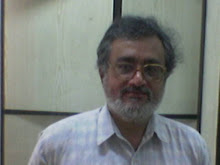The world is based on duality for creation itself is based on the premise of duality – that of the creator and the created. There is of course the state of advaita, which state alone can make us escape suffering. But how do we, in our created state, achieve the state of advaita? Well, surprising as it may seem, a state of advaita is available to us even as we live in the state of dvaita. It is available in the realm of consciousness. Brahman in advaita state moves to the state of Ishwar or dvaita upon creation. While the creative aspect of Brahman, i.e. Ishwar is separate from his creation, Brahman itself is inherent in all creation as well as non-creation. For the nature of Brahman is consciousness and when He ‘divides’ consciusness and becomes Ishwar, He still remains Brhaman, undivided that is, when Ishwar becomes, Brahman continues, as Ishwar has come to be in a different level of consciousness. So the core or essense or substratum is always Brahman. If we, in our limited state of consciousness, realise Ishwar (God), we shall come to rest in a state of Brahman. God realisation does not make us god, for god's is a different function altogether (the function of creation), which man cannot be, but a god-realised man becomes ‘greater’ than god, because he becomes Brahman. So potentially, man is greater than god. There should be no misunderstanding here. God as understood in the English language, is an entity of limited function, as man is. Only, god is the father and man the son. Not for nothing has it been said that ‘I and my father are one.’ When the totality of creation realises its inherent absoluteness, then everything, including god, dissolves in that totality and Brahman alone would be. This is the state of advaita, which indeed is the goal of man and of all creation.
Where do Christianity and Islam stand in the light of the Hindu idea of Advaita and Brahman? Jesus and Mohammad, as many others all through the ages, are individuals who have realised their potential and returned to Brahman or attained moksha. On their path towards realisation of their divinity or upon realisation of their divinity, such mighty men record their vision and seek to guide others to the path. It is this guidance that has taken the shape of the Quran, Bible and the Vedas. God of course is always aware of his divine state and sometimes he himself gets into his creation to guide mankind and thus an avatar comes to being. So creation learns of its potential from the creator himself and this potential surpasses both creator and creation, that is, transcends the duality and comes to a state of advaita. We can in a way say that dwaita is the basic reality because advaita itself presupposes a potential for dwaita. This might seem to be the logic but this logic is only applicable to the world of dwaita. Advaita is not the opposite of dwaita because the duality exists only in the world of dwaita. Brahman always is. The sea always is, not the waves, which is and is not. Can we say that in the realm of advaita there is no dvaita? Whence has come creation? From where has Ishwar been produced? From Brahman, of course. And yet, Brahman is not reduced in the formation of Ishwar. This truth is encapsulated in what is probably the greatest spritual teaching of all time, the teaching of the Shanti Mantra which is in the beginning of Ishavasyopanishad and Brihadaranyakopanishad - Om Poornam Adah Poornam Idam Poornaat Poornam Udachyate Poornasya Poornam Aadaay Poornam Evaa Vashishyate (That is complete, this is complete - from the complete, the complete has emerged, giving completeness of complete, the complete remains).
Where do Christianity and Islam stand in the light of the Hindu idea of Advaita and Brahman? Jesus and Mohammad, as many others all through the ages, are individuals who have realised their potential and returned to Brahman or attained moksha. On their path towards realisation of their divinity or upon realisation of their divinity, such mighty men record their vision and seek to guide others to the path. It is this guidance that has taken the shape of the Quran, Bible and the Vedas. God of course is always aware of his divine state and sometimes he himself gets into his creation to guide mankind and thus an avatar comes to being. So creation learns of its potential from the creator himself and this potential surpasses both creator and creation, that is, transcends the duality and comes to a state of advaita. We can in a way say that dwaita is the basic reality because advaita itself presupposes a potential for dwaita. This might seem to be the logic but this logic is only applicable to the world of dwaita. Advaita is not the opposite of dwaita because the duality exists only in the world of dwaita. Brahman always is. The sea always is, not the waves, which is and is not. Can we say that in the realm of advaita there is no dvaita? Whence has come creation? From where has Ishwar been produced? From Brahman, of course. And yet, Brahman is not reduced in the formation of Ishwar. This truth is encapsulated in what is probably the greatest spritual teaching of all time, the teaching of the Shanti Mantra which is in the beginning of Ishavasyopanishad and Brihadaranyakopanishad - Om Poornam Adah Poornam Idam Poornaat Poornam Udachyate Poornasya Poornam Aadaay Poornam Evaa Vashishyate (That is complete, this is complete - from the complete, the complete has emerged, giving completeness of complete, the complete remains).

No comments:
Post a Comment